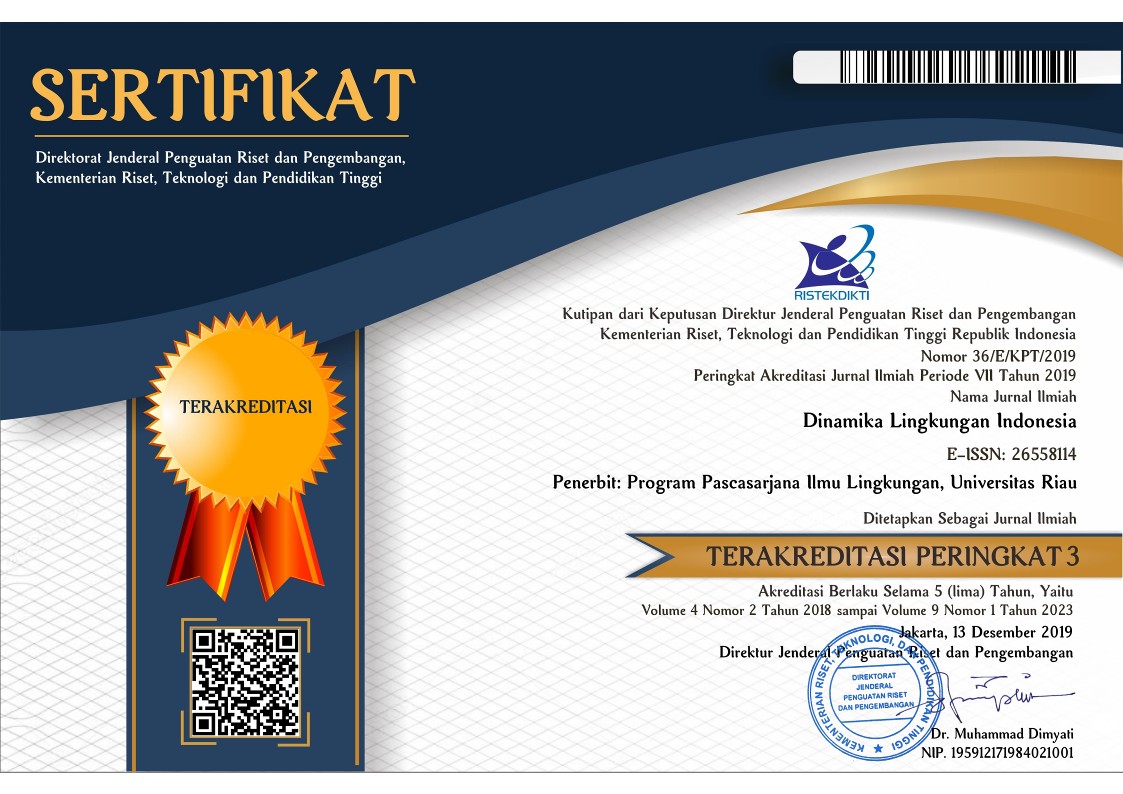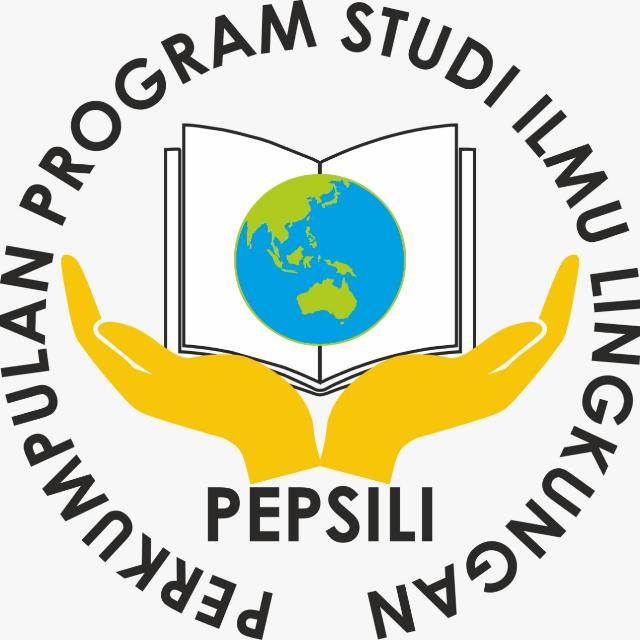Mangrove Riau: sebaran dan status perubahan
Abstract
Keywords
Full Text:
PDFReferences
Adrianto, H. A., Spracklen, D. V., Arnold, S. R., Sitanggang, I. S., & Syaufina, L. (2020). Forest and Land Fires Are Mainly Associated with Deforestation in Riau Province, Indonesia. 12(1), 3. https://www.mdpi.com/2072-4292/12/1/3.
Alongi, D. M., & Mukhopadhyay, S. K. (2015). Contribution of mangroves to coastal carbon cycling in low latitude seas. Agricultural and Forest Meteorology, 213, 266-272. https://doi.org/10.1016/j.agrformet.2014.10.005.
Arifanti, V. B. (2020). Mangrove management and climate change: a review in Indonesia. IOP Conference Series: Earth and Environmental Science, 487, 012022. https://doi.org/10.1088/1755-1315/487/1/012022.
Aziz, A. A., Thomas, S., Dargusch, P., & Phinn, S. (2016). Assessing the potential of REDD+ in a production mangrove forest in Malaysia using stakeholder analysis and ecosystem services mapping. Marine Policy, 74, 6-17. http://dx.doi.org/10.1016/j.marpol.2016.09.013.
Besset, M., Gratiot, N., Anthony, E. J., Bouchette, F., Goichot, M., & Marchesiello, P. (2019). Mangroves and shoreline erosion in the Mekong River delta, Viet Nam. Estuarine, Coastal and Shelf Science, 226, 106263.
https://doi.org/10.1016/j.ecss.2019.106263.
Bunting, P., Rosenqvist, A., Lucas, R. M., Rebelo, L.-M., Hilarides, L., Thomas, N., Hardy, A., Itoh, T., Shimada, M., & Finlayson, C. M. (2018). The Global Mangrove Watch—A New 2010 Global Baseline of Mangrove Extent. Remote Sensing, 10(10), 1669. https://www.mdpi.com/2072-4292/10/10/1669.
Cameron, C., Hutley, L. B., Friess, D. A., & Munksgaard, N. C. (2019). Hydroperiod, soil moisture and bioturbation are critical drivers of greenhouse gas fluxes and vary as a function of landuse change in mangroves of Sulawesi, Indonesia. Science of The Total Environment, 654, 365-377. https://doi.org/10.1016/j.scitotenv.2018.11.092.
Choong, E. T., Wirakusumah, R. S., & Achmadi, S. S. (1990). Mangrove forest resources in Indonesia. Forest Ecology and Management, 33-34, 45-57. https://doi.org/10.1016/0378-1127(90)90183-C.
Critchley, L. P., Bugnot, A. B., Dafforn, K. A., Marzinelli, E. M., & Bishop, M. J. (2021). Comparison of wrack dynamics between mangrove forests with and without seawalls. Science of The Total Environment, 751, 141371. https://doi.org/10.1016/j.scitotenv.2020.141371.
Daniel, P. A., & Robertson, A. I. (1990). Epibenthos of mangrove waterways and open embayments: Community structure and the relationship between exported mangrove detritus and epifaunal standing stocks. Estuarine, Coastal and Shelf Science, 31(5), 599-619. https://doi.org/10.1016/0272-7714(90)90015-J.
Davie, J., & Sumardja, E. (1997). The protection of forested coastal wetlands in Southern Sumatra: a regional strategy for integrating conservation and development. Pacific Conservation Biology, 3(4), 366-378. https://doi.org/10.1071/PC980366.
Garcia, M. R., & Martins, C. C. (2021). A systematic evaluation of polycyclic aromatic hydrocarbons in South Atlantic subtropical mangrove wetlands under a coastal zone development scenario. Journal of Environmental Management, 277, 111421. https://doi.org/10.1016/j.jenvman.2020.111421.
Giesen, W., Wulffraat, S., Zieren, M., & Scholten, L. (2007). Mangrove guidebook for southeast asia. FAO and Wetlands International.
Giri, C., Ochieng, E., Tieszen, L. L., Zhu, Z., Singh, A., Loveland, T., Masek, J., & Duke, N. (2011). Status and distribution of mangrove forests of the world using earth observation satellite data. Global Ecology and Biogeography, 20(1), 154-159. https://doi.org/10.1111/j.1466-8238.2010.00584.x.
Goldberg, L., Lagomasino, D., Thomas, N., & Fatoyinbo, T. (2020). Global declines in human-driven mangrove loss. Global Change Biology, 26(10), 5844-5855. https://doi.org/10.1111/gcb.15275.
Hartini, S., Saputro, G. B., & Niendyawati, d. (2010). Review on a national mangrove mapping: Case Study on the Indonesia Mangrove Mapping by BAKOSURTANAL Globe, 12(2), 146-150.
Ilman, M., Dargusch, P., Dart, P., & Onrizal. (2016). A historical analysis of the drivers of loss and degradation of Indonesia’s mangroves. Land Use Policy, 54, 448-459. http://dx.doi.org/10.1016/j.landusepol.2016.03.010.
Ilman, M., Wibisono, I., & Suryadiputra, N. (2011). State of the Art Information on Mangrove Ecosystems in Indonesia. https://doi.org/10.13140/RG.2.1.3967.9120.
Jennerjahn, T. C. (2020). Relevance and magnitude of 'Blue Carbon' storage in mangrove sediments: Carbon accumulation rates vs. stocks, sources vs. sinks. Estuarine, Coastal and Shelf Science, 107027. https://doi.org/10.1016/j.ecss.2020.107027.
Jhonnerie, R., Prianto, E., & Oktorini, Y. (2007). Deteksi perubahan luasan hutan mangrove denan menggunakan penginderaan jauh dan sistem informasi geografis di Kota Dumai, Provinsi Riau. Torani, 17(2), 159-169.
Jhonnerie, R., Siregar, V., Nababan, B., Prasetyo, L., & Wouthuyzen, S. (2014). Deteksi perubahan tutupan mangrove menggunakan citra Landsat berdasarkan klasifikasi hibrida di Sungai Kembung, Pulau Bengkalis, Provinsir Riau. Jurnal Ilmu dan Teknologi Kelautan Tropis, 6, 191-206.
Margono, B. A., Usman, A. B., Budiharto, & Sugardiman, R. A. (2016). Indonesian's forest resources monitoring. Indonesian Journal of Geography, 48(1), 7 - 20. https://jurnal.ugm.ac.id/ijg/article/download/12496/9041.
Marley, G. S. A., Deacon, A. E., Phillip, D. A. T., & Lawrence, A. J. (2020). Mangrove or mudflat: Prioritising fish habitat for conservation in a turbid tropical estuary. Estuarine, Coastal and Shelf Science, 240, 106788.
https://doi.org/10.1016/j.ecss.2020.106788.
Martosubroto, P., & Naamin, N. (1977). Relationship between tidal forests (mangroves) and commercial shrimp prodictution in Indonesia. Marine Research in Indonesia, 18, 81-86. https://doi.org/10.14203/mri.v18i0.363.
Miswadi, Ramses & R. Jhonnerie. 2017. Pemanfaatan Kayu Mangrove oleh Masyarakat Suku Asli Sungai Liong Pulau Bengkalis. Dinamika Maritim, 1(1): 35-39.
Momose, K. & T. Shimamura. 2002. Environment and People of Sumatran Peat Swamp Forest I: Distribution and Typology of Vegetation, South East Asia Study 40: 72-84.
Mustafa Kamal, A. H., Hoque, M. M., Idris, M. H., Billah, M. M., Karim, N. U., & Bhuiyan, M. K. A. (2020). Nutrient properties of tidal-borne alluvial sediments from a tropical mangrove ecosystem. Regional Studies in Marine Science, 36, 101299. https://doi.org/10.1016/j.rsma.2020.101299.
Prihatna, M. S., Nurdiana, A., & Luky, A. (2006). Analisis Ekonomi Alternatif Pengelolaan Ekosistem Mangrove Kecamatan Barru, Kabupaten Barru. Buletin Ekonomi Perikanan, 6(3).
Rahadian, A., Prasetyo, L. B., Setiawan, Y., & Wikantika, K. (2019). Tinjauan historis data dan informasi luas mangrove Indonesia. Media Konservasi, 24(2), 163 - 178.
Ramdani, F., & Hino, M. (2013). Land Use Changes and GHG Emissions from Tropical Forest Conversion by Oil Palm Plantations in Riau Province, Indonesia. PLOS ONE, 8(7), e70323. https://doi.org/10.1371/journal.pone.0070323.
Rasquinha, D. N., & Mishra, D. R. (2020). Impact of wood harvesting on mangrove forest structure, composition and biomass dynamics in India. Estuarine, Coastal and Shelf Science, 106974. https://doi.org/10.1016/j.ecss.2020.106974.
Richards, D. R., & Friess, D. A. (2016). Rates and drivers of mangrove deforestation in Southeast Asia, 2000–2012. Proceedings of the National Academy of Sciences, 113(2), 344-349. https://doi.org/10.1073/pnas.1510272113.
Silvius, M. J., Steeman A. P. J. M., Berczy E. T., Djuharsa E., Taufik A. 1987. The Indonesian Wetland Inventory. A Preliminary Compilation of Existing Information on Wetlands of Indonesia. Bogor.
Spalding, M., Kainume, M., & Collins, L. (2010). World atlas of mangroves. British: Routledge, pp 336.
Sukardjo, S. (2000). Indonesia: mangrove-friendly aquaculture. In J. H. Primavera, L. M. B. Garcia, M. T. Castaños, & M. B. Surtida. Mangrove-Friendly Aquaculture. Philippines: SEAFDEC Aquaculture Departement.
Van Oudenhoven, A. P. E., Siahainenia, A. J., Sualia, I., Tonneijck, F. H., van der Ploeg, S., de Groot, R. S., Alkemade, R., & Leemans, R. (2015). Effects of different management regimes on mangrove ecosystem services in Java, Indonesia. Ocean & Coastal Management, 116, 353-367. https://doi.org/10.1016/j.ocecoaman.2015.08.003.
Yan, J., Su, F., & Wang, M. (2017). The development processes and regional differentiation of both banks of the Strait of Malacca during 1980–2010. Ocean & Coastal Management, 139, 141-152. https://doi.org/10.1016/j.ocecoaman.2017.02.012
Zu Ermgassen, P. S. E., Mukherjee, N., Worthington, T. A., Acosta, A., Rocha Araujo, A. R. d., Beitl, C. M., Castellanos-Galindo, G. A., Cunha-Lignon, M., Dahdouh-Guebas, F., Diele, K., Parrett, C. L., Dwyer, P. G., Gair, J. R., Johnson, A. F., Kuguru, B., Savio Lobo, A., Loneragan, N. R., Longley-Wood, K., Mendonça, J. T., Meynecke, J.-O., Mandal, R. N., Munga, C. N., Reguero, B. G., Rönnbäck, P., Thorley, J., Wolff, M., & Spalding, M. (2020). Fishers who rely on mangroves: Modelling and mapping the global intensity of mangrove-associated fisheries. Estuarine, Coastal and Shelf Science, 106975. https://doi.org/10.1016/j.ecss.2020.106975.
DOI: http://dx.doi.org/10.31258/dli.9.1.p.50-57
Refbacks
- There are currently no refbacks.





